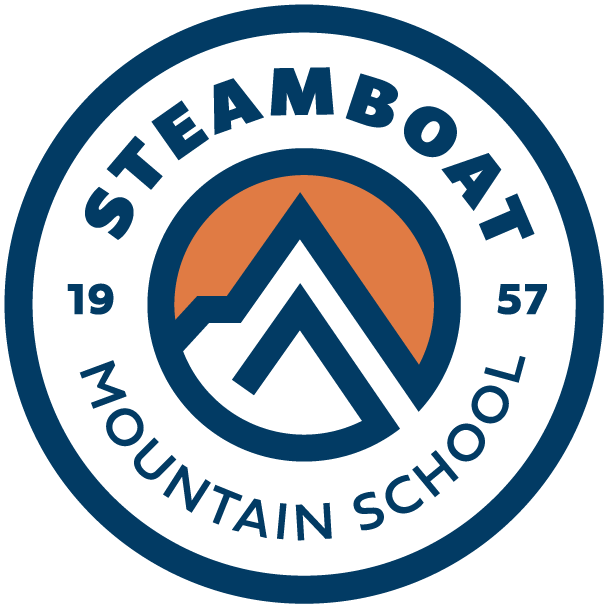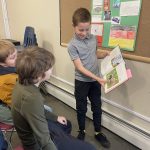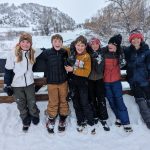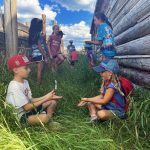In remembering her 23 years at Steamboat Mountain School, Meg Morse shares about the deep roots of this place, its programs, and its people.
Friday, June 3rd, 2022
Dear friends,
Writing about the students against the backdrop of graduation and Alumni Weekend is particularly meaningful. On graduation weekend, I get to listen to the speeches the faculty carefully craft for each senior, and then on the following weekend, adult versions of former students return with their spouses, children, and stories of their time here and their lives now. Paired with opening weekend in the fall, these events perfectly frame the deep connection we form with students.
Opening weekend in the fall is all about potential. Students who are joining the upper school for the first time greet us with their tentative handshakes, nervous smiles, and glimmers of hope in their eyes. Students returning to the school seek out hugs with their friends and faculty members alike and readily speak of their new plans and lofty goals. Whether new or returning, these students share the same sense of promise, the same sense of anticipation. Their stories are yet to unfold, but the prospect of new adventures, connections, challenges, and successes creates an energetic buzz that permeates each interaction.
What happens between a student’s first opening weekend and their graduation weekend creates a carefully constructed mosaic of moments. Each moment on its own and seen up close has a latent beauty. It has its own particular shape and color. As the pieces start to form patterns and share their individual subtleties with their neighbors, the effect becomes captivating. With the distance and perspective afforded by graduation, a full picture emerges that is breathtaking.
I love each of these moments; they are vividly imprinted in my memories. When I became an administrator I bought a candy jar so that students would stop by my office and tell me the best part of their day. The resulting raucous laughter, joyful dialogue, and not-so-subtle attempts to pocket more than the allotted number of candies, energized me every day. I also stocked my office with boxes of tissues for those times when the conversations were more difficult, weighty, and emotional. Knowing the uniting force of baked treats, Friday nights became Game Nights, and the promise of brownies drew students into our home for Catchphrase, Fishbowl, Mafia, and more laughter.
I have traveled the world with students, sitting next to them as we watched the sun set in Halong Bay or petted a cheetah in South Africa. We have spent countless hours on planes, trains, and automobiles exchanging life stories and talking about inconsequential matters. We bickered over the best way to roast a marshmallow, sang the Steamboat Mountain School version of the Twelve Days of Christmas, and howled after the Bell Ceremony. By the time we got to graduation, we were connected in ways that defies the passing of time.
I have always said that being a teacher provides a yearly lesson in the process of letting go. The seniors whom we love so much graduate, and they head off to explore the world on their own. Their parting, however, is made more tolerable by the knowledge that they will return throughout the years and invite us back into their lives with their stories. They return for Alumni Weekend, not frozen in time as the eighteen-year-olds that I remember, but grown into fascinating adults with careers, spouses, and children. They sometimes express regret for the mistakes they made, all of which I have entirely forgotten, and we always laugh and reminisce about all the good times, all of which I remember.
As my time at the school draws to a close, I am reminded of a Charles Dickens quote: “Life is made of ever so many partings welded together.” Although parting is hard, it is the connection, the welding, the mosaic that softens the blow. I know that campus will always feel like home, Alumni Weekend will always be on the calendar, and my memories will be the artwork that brings me joy, fills me with gratitude, and infuses my life with beauty.
Sincerely,
Meg Morse
Tuesday, May 10th, 2022
Dear friends,
Writing about the school programs has presented a greater quandary than I anticipated — not because I don’t have anything to say, but instead because I have too many stories to tell, too many moments that capture the essence of the experience. Like any student when faced with the myriad challenges offered by our programs, I have started, stopped, adjusted my approach, sought feedback, and persevered. Because the power of our programs stems from their interconnectedness, I know that I cannot do each program justice in this piece, but I hope that my observations encourage each of you to reminisce about your own interactions with the ecosystem that is our programs.
As our students learn in biology and environmental science, an ecosystem gathers its strength and resilience from the direct and indirect connections that link all of its elements. When many people think about our programs, they gravitate toward the signature programs: challenging academics, global studies, competitive skiing and snowboarding, service learning, and outdoor adventure. At many schools signature programs such as these are on a menu — pick and choose the ones that appeal to your palate, avoid those that seem distasteful. In our programmatic ecosystem, however, we recognize that the intertwined strength of these experiences fosters greater growth and develops resilience through the right level of adversity. I have watched students gain confidence in their ability to memorize “To be or not to be” precisely because they summited Long’s Peak, helped maintain mountain biking trails on Buff Pass, nailed their flip at the water ramps, or persevered in their struggle to communicate with their homestay family. These are the stories we tell prospective families because it is a language the uninitiated understand.
For those of us who really know the school, we understand that the strength of our more apparent programs lies in their connection to the next layer of nutrients — the chores, the advisory conversations, and yes, even the discipline system. Learning to clean a toilet to Margi’s satisfaction is not just about a clean toilet. It is about attention to detail, pride in place, the satisfaction gained in a discrete job done well. It is knowing that your effort matters. Building relationships in advisory and seeing issues from multiple perspectives is not just about social/emotional development. It allows a student to journal about their experience visiting the Killing Fields in Cambodia as a way of processing their emotions, considering their place in the world, and wrestling with their own relationships. Making a mistake and being held accountable is not just about upholding community standards. It teaches the importance of vulnerability, the powerful lessons inherent in failure, and the forgiveness necessary for trust to blossom. Each of these moments nourishes the root systems of the ecosystem.
Every member of the greater school community has a story to tell. Although their stories overlap and have common themes, each person’s collection is different. I like to think of these subtle differences as the butterfly effect of the ecosystem. For each person, one small flap of the wings — a well-timed piece of praise, an “aha” moment in the classroom, a personal best on the ski hill, a sunrise halfway around the world — changed everything. All other parts of the ecosystem reacted, developed resilience, and became more robust.
For me, the ecosystem of our programs is magical, a word that frequently works its way into conversations about this school. I see the magic as alchemy, the process of transforming base metals into gold, and that transformation occurs with all of us fortunate enough to live within the ecosystem. Every class, every student, every outdoor and global adventure, every moment at the school has changed me. For twenty-three years I have learned patience, compassion, forgiveness, courage, and resilience. I have grown because the ecosystem challenged me and supported me. I have joined the generations of people who were transformed by the programs at the school. Leaving the ecosystem is hard, as any graduate or parent of a graduate will tell you. The blow, however, is softened by the knowledge that we carry the strengths of the ecosystem within us, and that the ecosystem will continue to thrive, demonstrate resilience, and transform people fortunate enough to enter it.
Sincerely,
Meg Morse
Wednesday, April 27th, 2022
Dear friends,
As the air warms and the aspen tree outside my office window develops fuzzy catkins in preparation for its new leaves, my sentimental nature is similarly beginning to sprout in earnest. With less than two months left at the end of my twenty-three-year tenure at the school, each walk to and from our house takes on new meaning. Being a person of many words (as many of you know), I have asked for the opportunity to share some of my thoughts with you as a way of saying “goodbye” and expressing the profound gratitude I feel for Steamboat Mountain School.
Over the course of the next six weeks, I will write about the place, programs, and people that I love so much. While I know that I cannot fully express every meaningful aspect of my time at the school, I hope these musings will adequately reflect how deeply seated the school is in my heart. So, here we go with my first installment: the place.
Each time I round the curve just below school and watch as the buildings unfold in my vision, I feel the warmth and intimacy of campus with its stunning backdrop of aspen trees on Copper Ridge. Each building — Henderson Gym to Borden Center to Craig-Scheckman Student Education Center to Charley Williams Lodge — curves into the next and invites you into its embrace. They welcome you home with the hope that you will stay for a while.
When I enter the buildings, the echo of laughter, teenage voices raised with both excitement and drama, and pounding footfalls rushing toward the dining hall for Taco Tuesdays greets you. Every nook holds a story, and every rough surface, errant candy wrapper, and beautifully painted stair riser speaks of genuine love and connection. Our buildings have character. They are never pristine or sterile but always a tad disheveled and truly vibrant. I am not sure there is a corner in any of these buildings that I have not tucked into to do work, contemplate life, or play games with students. I know that each time I return, I will hear new stories unfolding while the echoes from the past provide the harmony to their melody.
Just as each building has its tale to tell, this glorious campus that Lowell Whiteman’s mother, Olive, gifted to him and which he in turn gifted to the school, hums with life. One of my favorite explorations on campus is the walk up to the South Pasture. As I leave the core campus and walk up past the dorms, I see all the faculty housing in which generations of faculty raised their families and helped create the community we all love.
When I take the left fork toward South Pasture, I always feel the pull toward the yurt with its idyllic setting and views, but I persevere onwards up the steep road until I gratefully wind down to the top of South Pasture. Without fail the view takes my breath away (as did the climb), and I pause by the old riding ring to take in my surroundings. My favorite part of the walk is winding downhill through the aspen trees to the ditch trail. Once I cross the ditch, I am almost never brave enough to careen down the steep slope of the ski hill, where students have played before, during, and after school. At the end of this circuit, I always feel connected to the rhythms of campus, the natural beauty of the land, and the deep roots of this place.
This campus will always be home to me. I have watched the sunlight creep down the ridge in the morning as I walked to breakfast and the alpenglow on Crystal Peak as I returned home at night. I have talked, played, laughed, and cried with faculty and students in every room on campus, and each inch of the buildings and the land holds my memories. When I drive away from campus in June, the road ahead will be blurred by my tears; however, when I return for a visit, I will round the bend below campus, and the school will embrace me once again, eager to share its stories and hear my own.
Sincerely,
Meg Morse



